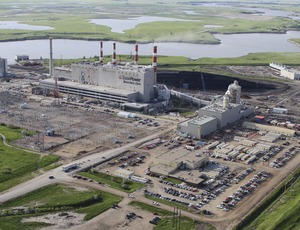
The world's first full-scale carbon capture and sequestration (CCS) facility of its kind at a commercial coal plant is performing better than expected, officials from SaskPower, the Canadian facility that owns the plant, said at a recent meeting in Washington, D.C.
CCS has been touted by the Obama administration and advocates around the globe as a way to enable coal to remain part of the energy mix in a carbon- constrained world. But many power utilities are reluctant to invest in CCS projects because they say the technology is untested at commercial scale in the power sector and that the plants are too expensive to build and operate.
At an April 8 meeting of the National Coal Council in Washington, D.C., SaskPower's president and CEO, Michael Marsh, described the CCS prototype project at a retrofitted unit at Boundary Dam, Saskatchewan, as "a phenomenal achievement [that] demonstrates what is possible."
He said that while the CCS facility still is ramping up after beginning operations in October 2014, it already is capturing 80% of greenhouse-gas emissions generated at the plant and is using less parasitic load than the design team had estimated. The plant was designed to achieve 90% CO2 capture, and SaskPower hopes to achieve that target by June, Marsh said.
The $1.467-billion project began construction in May 2011 to comply with more stringent Canadian greenhouse-gas emissions rules that will go into effect on July 1, 2015. The regulations require new and existing facilities to operate as cleanly as natural-gas facilities.
Before the project was completed, the unit was emitting 1,100 tons of CO2 per kw/h. When the facility reaches 90% capture, it will be emitting 140 tons of CO2 per kw/h, three times cleaner than the typical emissions from a natural-gas facility, Marsh said.
Still, the project has its critics. Saskatchewan Community Wind on March 26 released a report that questioned the facility's economic viability. The report said the project generated losses in excess of $1 billion for electricity consumers in Saskatchewan and that the oil industry will profit from a "below-cost" source of carbon dioxide for enhanced oil recovery. "Economically superior alternatives to Boundary Dam CCS include energy efficiency, wind energy, imports, natural gas, solar or biomass," wrote the report's author, James Glennie, president and founder of SCW, a wind-energy advocacy organization.
But Mike Monea, SaskPower's president of carbon capture and storage initiatives, in an email said, "The report appears to be based heavily on speculation and hypothesis, as opposed to fact. SaskPower is still fine-tuning the carbon-capture process, but we know that by factoring in the revenue from the sale of CCS by-products, the cost of electricity from [Boundary Dam's Unit 3] will be similar to any of our natural-gas units."
Nevertheless, SaskPower is planning to look at the facility's operations for a year before making a decision on two other Boundary Dam units, which are set for retirement in 2019. "CCS has much higher capital costs in the beginning, but, over the life of the plant, we see a very good economic case being made," Marsh said. Moreover, because of lessons learned, "we firmly believe we could build another facility like this for 20% to 30% less than what we experienced here," he added.
Elizabeth Burton, The Global CCS Institute's general manager, Americas, says that, although her group would not comment on the wind study, "Boundary Dam itself demonstrates how next-in-kind can be done at lower costs than first-in-kind." She notes that the historical pattern for technology is that costs decline following adoption and scale-up, saying, "The next one down the line is always cheaper than the last one."
Burton says technology-neutral policies are key to encouraging utilities to move forward with projects. She added, "Any kind of greenhouse-gas mitigation is going to cost money, but the cost of not doing anything is going to be significantly more expensive. … So, I think you have to look at CCS in that light."






Post a comment to this article
Report Abusive Comment